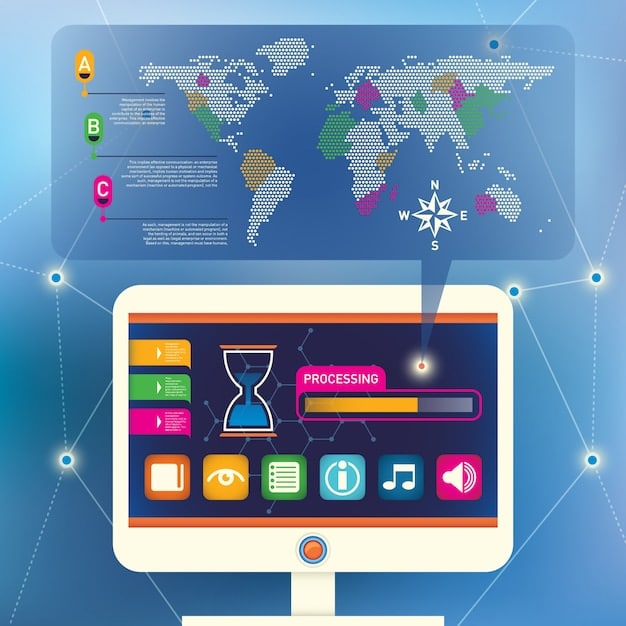Data Caps & Streaming: Avoid Overage Charges in US (2025)

Navigating the intersection of data caps and streaming: how to avoid overage charges in the US (2025) requires understanding your internet plan, monitoring data usage, and employing strategies like optimizing stream quality and leveraging unlimited data options to ensure a seamless and cost-effective entertainment experience.
As streaming continues to dominate our entertainment consumption, understanding the nuances of Data Caps and Streaming: How to Avoid Overage Charges in the US (2025) becomes increasingly vital. With more households cutting the cord, the reliance on internet data for movies, TV shows, and live events escalates, often pushing subscribers closer to their provider’s data limits.
Understanding Data Caps in the US
Data caps, also known as data limits or usage limits, are often imposed by Internet Service Providers (ISPs) in the United States to restrict the amount of data their subscribers can use within a billing cycle. Once this cap is exceeded, consumers typically face additional charges, known as overage fees, or experience throttled speeds.
This practice has been a contentious issue among consumers for years, especially as broadband usage continues to climb. In 2025, with more households relying solely on streaming for entertainment, work, and education, familiarity with these caps and their implications is more important than ever.
The Prevalence of Data Caps
While some ISPs offer unlimited data plans, a significant number, particularly those operating in areas with limited competition, still enforce data caps. These caps vary widely, ranging from a few hundred gigabytes (GB) to a terabyte (TB) or more. For many, a 1 TB data cap might seem substantial, but with 4K and 8K streaming becoming more common, and multiple devices connected simultaneously, it can be reached faster than anticipated. Providers often cite network management and fair usage policies as reasons for imposing these limits, aiming to ensure stability and quality of service for all users.
How Data Caps Impact Streaming
Streaming video is one of the most data-intensive activities online. The amount of data consumed depends heavily on the quality of the video stream. For instance, streaming in Standard Definition (SD) uses significantly less data than High Definition (HD), and 4K Ultra HD streams consume exponentially more. A single hour of 4K streaming can use up to 7 GB of data, meaning a family watching several movies or shows daily could easily exceed a 1 TB cap within a month.
- Standard Definition (SD): Approximately 0.7 GB per hour.
- High Definition (HD): Approximately 3 GB per hour.
- 4K Ultra HD: Approximately 7 GB per hour.
These figures quickly accumulate, especially when considering multiple users streaming concurrently on different devices. Understanding these consumption rates is the first step in managing your data usage effectively and avoiding unexpected overage charges for your favorite streaming content.
In short, knowing your ISP’s specific data cap and how your streaming habits align with it is crucial for budget-conscious consumers. Many providers offer tools or apps to track your usage, which can be invaluable for staying within your limits. The shift towards higher resolution content only exacerbates the challenge, making proactive data management a necessity rather than an option.
Strategies for Monitoring and Managing Data Usage
Effective data management is key to avoiding overage charges. It involves both monitoring your current usage and implementing habits that help conserve data. In 2025, with advanced tools and smart devices, managing your streaming data is more accessible than ever, provided you know where to look and what to do.
The first step is to proactively check your data usage. Most major ISPs provide online portals or dedicated mobile applications where customers can view their real-time or near real-time data consumption. Regularly checking these platforms, especially towards the end of your billing cycle, can alert you if you’re approaching your limit.
Utilizing ISP Tools and Features
Many ISPs offer features designed to help you stay within your data limits. These might include:
- Usage Alerts: Automated email or text notifications when you reach a certain percentage of your data cap (e.g., 75%, 90%).
- Data Dashboards: Detailed breakdowns of data usage by day or even by device, helping you identify which activities or devices are consuming the most data.
- Auto-Pause Features: Some smart home devices or routers allow users to set data limits or pauses for specific periods, though this is less common for overall household data.
It’s important to familiarize yourself with these tools provided by your specific ISP, as they are tailored to their systems and can offer the most accurate insights into your consumption patterns. Setting up alerts is particularly useful, offering a timely warning before you incur any unexpected charges.
Adjusting Streaming Quality and Habits
One of the most impactful ways to manage data is by adjusting the quality of your streaming content. While 4K offers stunning clarity, it’s not always necessary, especially for casual viewing on smaller screens where the difference might be negligible. Most streaming services allow you to manually adjust playback quality settings.
Consider the following adjustments to your streaming habits:
- Lower Default Quality: Change the default playback quality in your streaming service settings from 4K or HD to SD or a lower HD resolution (e.g., 720p instead of 1080p) for everyday viewing.
- Download Content: Many services like Netflix and Disney+ allow users to download content over Wi-Fi when on an unlimited or unmetered connection, which can then be watched offline without consuming additional data.
- Manage Multiple Streams: Be mindful of how many devices are streaming simultaneously. Multiple 4K streams can deplete a data cap extremely quickly.
- Disable Autoplay: Autoplay features, common on many streaming platforms, can lead to continuous data consumption even when you’re not actively watching, so consider turning them off.

By implementing these strategies, you can gain better control over your data consumption and significantly reduce the risk of hitting your data cap. It’s about making conscious choices that align with your data plan and viewing needs, rather than letting unlimited streaming automatically drain your allowance.
Regular check-ins and thoughtful adjustments to your viewing habits can make a substantial difference in managing your household’s data budget. The goal is to enjoy your streaming content without the looming worry of an unexpected bill at the end of the month.
Exploring Unlimited Data Options in 2025
For those who find data caps increasingly restrictive, especially with the rising popularity of high-definition streaming, exploring unlimited data options from ISPs is a proactive approach in 2025. While not always available or affordable in every region, these plans can offer peace of mind and eliminate the constant need to monitor usage.
The market for internet services is ever-evolving, and some providers have begun to recognize the consumer demand for limitless connectivity, particularly given the shift towards remote work and extensive streaming.
Types of Unlimited Data Plans
Unlimited data plans typically fall into a few categories, each with its own set of considerations:
- Truly Unlimited Plans: Some providers offer plans with no stated data cap, allowing for unrestricted usage. These are often premium plans and may come at a higher monthly cost.
- Soft Data Caps: In some cases, providers might advertise “unlimited” but include a “soft” data cap. Exceeding this cap doesn’t incur overage charges, but it might lead to a temporary reduction in internet speeds (throttling) during peak network congestion.
- Unlimited Data Add-ons: For plans with hard data caps, many ISPs offer the option to purchase an unlimited data add-on for an additional monthly fee. This is often a more cost-effective solution than paying per-gigabyte overage charges if you consistently exceed your cap.
It’s crucial to read the fine print of any “unlimited” plan. Look for terms like “network management,” “data prioritization,” or specific clauses about speed reductions after a certain usage threshold. Transparency from ISPs is improving, but consumer vigilance remains essential to understand what “unlimited” truly means for a given plan.
Comparing Providers and Plans
Shopping for an unlimited data plan requires careful comparison. Factors to consider include:
- Monthly Cost: Is the higher monthly fee for an unlimited plan justifiable compared to the potential overage charges you might incur? Calculate your average overage costs to make an informed decision.
- Available Speeds: Unlimited data is only useful if the speeds are sufficient for your streaming needs. Ensure the plan offers speeds adequate for multiple simultaneous HD or 4K streams.
- Contract Terms: Be aware of any long-term contracts, introductory pricing that expires, or cancellation fees.
- Customer Reviews: Look into customer feedback regarding the provider’s actual “unlimited” performance, especially concerning throttling or network congestion.
In rural areas, satellite internet or fixed wireless solutions might also offer unlimited data options, though these often come with higher latency or slower speeds compared to fiber or cable. However, their unlimited nature can be a significant advantage for heavy streamers.
Ultimately, investing in an unlimited data plan, if available and affordable, can significantly simplify your streaming experience by removing the constant concern of data overages. It offers the freedom to stream as much as desired without financial penalties, aligning with the growing trend of digital-first entertainment consumption.
Leveraging Device and App Settings to Save Data
Beyond your ISP’s tools, many of the devices and streaming applications you use daily offer built-in settings that can dramatically help reduce data consumption. Understanding and configuring these settings is a powerful way to take control of your data usage, especially when streaming video content. These subtle adjustments can collectively lead to substantial savings over a billing cycle.
Each streaming service, from Netflix to YouTube, typically includes options within its settings to manage video quality. While the default might be set to “Auto” or the highest possible quality based on your internet speed, manually selecting a lower resolution can significantly cut down on data use without necessarily degrading the viewing experience on smaller screens.
Specific App Settings to Adjust
Here’s a breakdown of common settings you can adjust within popular streaming apps and devices:
- Netflix: Go to “Account” -> “Profile & Parental Controls” -> Select your profile -> “Playback settings.” You’ll find options like “Auto,” “Low,” “Medium,” and “High.” Opting for “Medium” (SD) or “High” (HD, but not 4K) can save data.
- YouTube: While watching a video, tap the gear icon (settings) -> “Quality.” You can select a lower resolution (e.g., 480p or 720p). For mobile devices, there’s often an option to set mobile data usage to “Data saver” mode within the app’s general settings.
- Hulu, Disney+, Amazon Prime Video: Similar to Netflix and YouTube, these services have video quality settings within their respective apps, usually found in “Settings” or during playback via a gear icon. Look for options to set streaming quality to “Good,” “Medium,” or similar lower resolutions.
- Smart TVs and Streaming Devices (Roku, Apple TV, Fire Stick): Some devices have general video quality settings that can override or influence app settings. Explore the display or network settings of your smart TV or streaming box to see if you can set a maximum resolution output. For instance, if your TV is 1080p, ensure the device isn’t trying to send a 4K signal that consumes unnecessary data.
Considerations for Offline Viewing and Background Data
Beyond direct streaming quality, other settings can help conserve data:
- Download for Offline Viewing: As mentioned, many services allow you to download content (e.g., movies, episodes) to your device for offline viewing. This is ideal when you have access to unmetered Wi-Fi (at home, work, or public hotspots) and can then watch the content later without using mobile or home internet data.
- Limit Background App Refresh: On mobile devices, background app refresh can consume data even when you’re not actively using a streaming app. Disable this for streaming apps that don’t need to refresh content in the background.
- Disable Auto-Updates: Ensure your apps and operating systems are set to update only over Wi-Fi, not mobile data, to avoid unexpected data spikes.
- Turn Off Auto-Play Previews: Many streaming platforms feature auto-play previews on their home screens. While minor, these can accumulate data usage. Disabling them in settings can contribute to overall data conservation.
By taking a few minutes to configure these settings across your devices and preferred streaming applications, you can significantly reduce your data footprint. This proactive approach ensures you maximize your viewing pleasure within your data allowance, making for a smarter and more cost-effective streaming experience in 2025.

Alternative Connectivity Solutions
While traditional wired and fixed wireless internet are common, exploring alternative connectivity solutions can be a viable strategy for those facing persistent data cap issues, especially in regions with limited ISP competition or specific usage patterns. These options, though sometimes niche, can offer greater flexibility in data usage for streaming in 2025.
The landscape of internet connectivity is expanding, offering more options beyond standard cable or fiber optic lines. Satellite internet, 5G home internet, and even mobile hotspots can serve as primary or supplementary connections, each with its unique advantages and disadvantages concerning data caps.
5G Home Internet
5G home internet, offered by major mobile carriers like T-Mobile and Verizon, is rapidly expanding across the US. A significant advantage of many 5G home internet plans is their offer of unlimited data, or at least very high data caps, making them an attractive option for heavy streamers. It uses the same 5G network as mobile phones but is designed to provide broadband-like speeds to your home.
- Pros: Often unlimited data, competitive pricing, easy setup (plug-and-play), and potentially fast speeds depending on 5G coverage in your area.
- Cons: Availability is location-dependent, speeds can vary based on network congestion and signal strength, and some plans may deprioritize data during peak times.
For many urban and suburban dwellers, 5G home internet presents a compelling alternative to traditional wired connections, offering a high-speed, data-cap-free streaming experience.
Satellite Internet
Primarily serving rural and underserved areas, satellite internet (e.g., from Starlink, Viasat, HughesNet) has traditionally been known for lower speeds and strict data caps. However, services like Starlink are changing this paradigm by offering higher speeds and, in some cases, truly unlimited or significantly larger data allowances, albeit with higher latency due to the signal traveling to space and back.
- Pros: Widespread availability even in very remote areas where other broadband options are scarce, and newer services are offering improved speeds and data options.
- Cons: Higher latency can impact real-time activities, and traditional satellite providers still often impose data caps, though Starlink aims to be an exception.
For those in locations without access to robust wired or 5G infrastructure, satellite internet remains a critical, and increasingly viable, solution for enabling streaming.
Mobile Hotspots and Data Plans
While not ideal for primary home internet for heavy users, mobile hotspots (either dedicated devices or through smartphone tethering) can be a useful backup or solution for light streamers. Most mobile phone plans include a certain amount of high-speed data that can be used for tethering, with speeds often significantly reduced once that limit is reached.
- Pros: Portability, convenient for occasional use or travel, utilizes existing phone plan data.
- Cons: Limited data allowances for high-speed streaming, speeds can be throttled quickly, and can quickly deplete your mobile phone’s battery.
Exploring these alternatives means evaluating your specific needs, location, and budget. For those consistently struggling with data caps on traditional ISPs, a change in connectivity type might provide the much-needed freedom to stream without concern.
Legal and Regulatory Landscape of Data Caps (2025)
The regulatory environment surrounding data caps in the US has been a dynamic one, reflecting evolving consumer demands and technological advancements. In 2025, while there isn’t a nationwide ban on data caps, the conversation around their fairness and necessity continues to evolve, influenced by consumer advocacy, state legislation, and the competitive landscape.
Unlike some other countries, the US does not have federal regulations explicitly prohibiting ISPs from imposing data caps. The Federal Communications Commission (FCC) has primarily focused on promoting broadband deployment and competition rather than direct regulation of data caps, though it has historically encouraged transparency from providers regarding their policies.
Net Neutrality and Data Caps
The debate over net neutrality often intersects with data caps. While not directly linked, the principle of net neutrality—that ISPs should treat all internet traffic equally—can indirectly influence how data caps are applied. For instance, zero-rating (where certain content, like an ISP’s own streaming service, doesn’t count towards a data cap) has been contentious under net neutrality principles due to concerns about anti-competitive practices.
As of 2025, the regulatory status of net neutrality continues to be debated and can shift depending on the political climate and court rulings. Any strong re-establishment of net neutrality rules could potentially lead to greater scrutiny of data cap practices that are seen as unfairly disadvantaging certain content or services.
State-Level Actions and Consumer Advocacy
Given the lack of federal mandates, some states have taken their own initiatives. While direct bans on data caps are rare, some states may impose stronger consumer protection laws that require clearer disclosure of data cap policies, overage charges, and options for unlimited plans. Consumer advocacy groups play a significant role here, pushing for greater transparency, fair pricing, and accessible broadband for all Americans, often highlighting the burden data caps place on low-income families.
The collective pressure from consumer groups, combined with potential state-level legislative action, contributes to the ongoing discussion and could influence ISP policies over time. Some providers, facing public scrutiny or competitive pressure, have occasionally adjusted or removed data caps in certain markets.
The Future Outlook for Data Caps
Looking ahead to 2025 and beyond, several factors could influence the prevalence and severity of data caps:
- Increased Competition: The expansion of 5G home internet, fixed wireless, and fiber broadband into more areas could force traditional ISPs to offer more competitive plans, including unlimited data, to retain customers.
- Technological Advancements: More efficient data compression and network management technologies might make data caps less necessary for ISPs in the future.
- Evolving Consumer Expectations: As streaming becomes the primary mode of content consumption, consumer tolerance for restrictive data caps may decrease, prompting providers to adapt their business models.
While a complete disappearance of data caps by 2025 is unlikely, the trend points towards a more competitive environment where unlimited options become more accessible. Consumers remain at the forefront of driving these changes by choosing providers who meet their demand for unconstrained digital experiences.
Advanced Tips for High-Volume Streamers
For households that consistently stream large volumes of content, whether it’s 4K movies, competitive online gaming, or extensive cloud-based work, managing data caps requires more than just basic adjustments. High-volume streamers need advanced strategies to truly circumvent or optimize their data consumption in 2025.
These tips move beyond simple quality adjustments and delve into network configuration, software solutions, and strategic planning to ensure a seamless, high-data-usage experience without incurring exorbitant overage fees. The goal is to maximize efficiency and minimize unnecessary data transfer.
Optimize Router and Network Settings
Your Wi-Fi router can be a powerful tool in managing data if configured correctly:
- Quality of Service (QoS) Settings: Many modern routers offer QoS features that allow you to prioritize certain types of traffic or specific devices. For example, you can prioritize streaming devices or gaming consoles to ensure they receive sufficient bandwidth, while deprioritizing less critical traffic. Some advanced QoS settings can even help manage data flow more efficiently, preventing unnecessary spikes.
- Firmware Updates: Regularly updating your router’s firmware can improve its efficiency, security, and sometimes introduce new data management features. Keep your network hardware up-to-date for optimal performance.
- Guest Network Management: If you frequently have guests using your Wi-Fi, consider setting up a guest network with limited bandwidth or time limits. This prevents guest usage from inadvertently impacting your primary data cap or network performance.
These router-level adjustments offer a centralized way to manage how data is used across all connected devices in your home, providing a layer of control beyond individual app settings.
Explore Content Delivery Networks (CDNs) and VPN Usage
While typically not a direct data-saving measure, some choices related to how content is delivered can indirectly affect perceived data use:
- CDN Awareness: Streaming services rely on Content Delivery Networks (CDNs) that cache content geographically closer to users. While you can’t choose your CDN, understanding that your ISP might have peering agreements that make certain CDNs more efficient might subtly affect data traffic. More importantly, using services that have well-distributed CDNs can often lead to more stable streams, reducing buffering which sometimes leads to re-downloading segments.
- VPN Considerations: A Virtual Private Network (VPN) encrypts your internet traffic, routing it through a secure server. While this enhances privacy and can allow access to geo-restricted content, it doesn’t typically reduce data usage; in fact, the encryption overhead might even slightly increase it. However, if your ISP has specific throttling rules based on content type, a VPN could potentially obscure that traffic classification, though this is a less common and more complex scenario for data cap circumvention.
The primary benefit of a VPN is security and access, not data reduction. Use it judiciously if data caps are your main concern, understanding its actual impact on consumption.
Utilize Cloud Storage & Smart Device Management
Modern homes are filled with smart devices that continuously consume data, often in the background:
- Cloud Backups: Schedule large cloud backups (e.g., photos, files) for periods when data usage is lower or when you know your ISP offers “off-peak” unmetered data (if applicable).
- Smart Home Device Monitoring: Devices like security cameras that continuously stream video can be significant data users. Check their settings for options to adjust streaming quality, motion-only recording, or localized storage instead of constant cloud uploads.
- Power Down Unused Devices: Simple, but effective. Devices that are always on and connected can still use small amounts of background data. Powering them off when not in use can contribute to overall data savings over time.
For high-volume streamers, every gigabyte counts. Adopting these advanced strategies not only helps manage data caps but also optimizes your entire home network for a superior and worry-free digital experience in 2025.
| Key Point | Brief Description |
|---|---|
| 📊 Data Monitoring | Regularly check ISP portals/apps for real-time usage to avoid surprises. |
| ⚙️ Quality Adjustment | Lower streaming resolution (e.g., to HD/SD) directly in app settings to save GBs. |
| Unlimited Plans | Consider upgrading to unlimited data plans or add-ons if constantly exceeding limits. |
| 🌐 Alternative ISPs | Explore 5G home internet or satellite options which often offer higher or unlimited data. |
Frequently Asked Questions
▼
A data cap is a limit imposed by your Internet Service Provider (ISP) on the amount of data you can download and upload within a monthly billing cycle. Once you exceed this preset limit, typically measured in gigabytes (GB) or terabytes (TB), your ISP may charge overage fees or significantly slow down your internet speeds until the next cycle. This practice helps ISPs manage network traffic and capacity.
▼
Streaming content in 4K Ultra HD quality is highly data-intensive, typically consuming around 7 gigabytes (GB) per hour. This is significantly more than High Definition (HD) streaming, which uses about 3 GB per hour, or Standard Definition (SD), at roughly 0.7 GB per hour. Multiple 4K streams by different users in a household can quickly deplete a common 1 Terabyte (TB) data cap.
▼
Yes, absolutely. Lowering the streaming quality is one of the most effective ways to conserve data. Most streaming services allow you to manually select resolutions like SD (Standard Definition) or 720p HD instead of 1080p HD or 4K. While 4K offers superior visuals, for casual viewing or on smaller screens, a lower resolution significantly reduces data consumption, helping you stay within your data cap.
▼
Many “unlimited” data plans come with a “soft” data cap. While you won’t incur overage charges, exceeding a certain usage threshold might lead to temporary speed reductions (throttling) during network congestion. It’s crucial to read the fine print of any unlimited plan to understand its specific terms, particularly regarding data prioritiation, and whether there are any hidden usage limitations or speed tiers that apply after heavy consumption.
▼
Mobile hotspots can be a supplementary option for light streaming, especially when on the go or as a backup. However, they are generally not ideal as a primary home internet solution for heavy streamers. Most mobile phone plans include limited high-speed data for tethering, which can be quickly exhausted by streaming, leading to significant speed reductions. Consider them for occasional, not continuous, high-volume streaming.
Conclusion
Navigating the complex landscape of data caps and streaming in the US for 2025 demands a proactive and informed approach. By diligently monitoring your data usage, optimizing streaming quality through various device and app settings, and actively exploring unlimited data plans or alternative connectivity solutions like 5G home internet, consumers can effectively sidestep burdensome overage charges. The power to control your digital consumption lies in understanding the interplay between your habits and your ISP’s policies, ensuring that your streaming experience remains enjoyable, seamless, and cost-effective rather than a source of financial strain.





